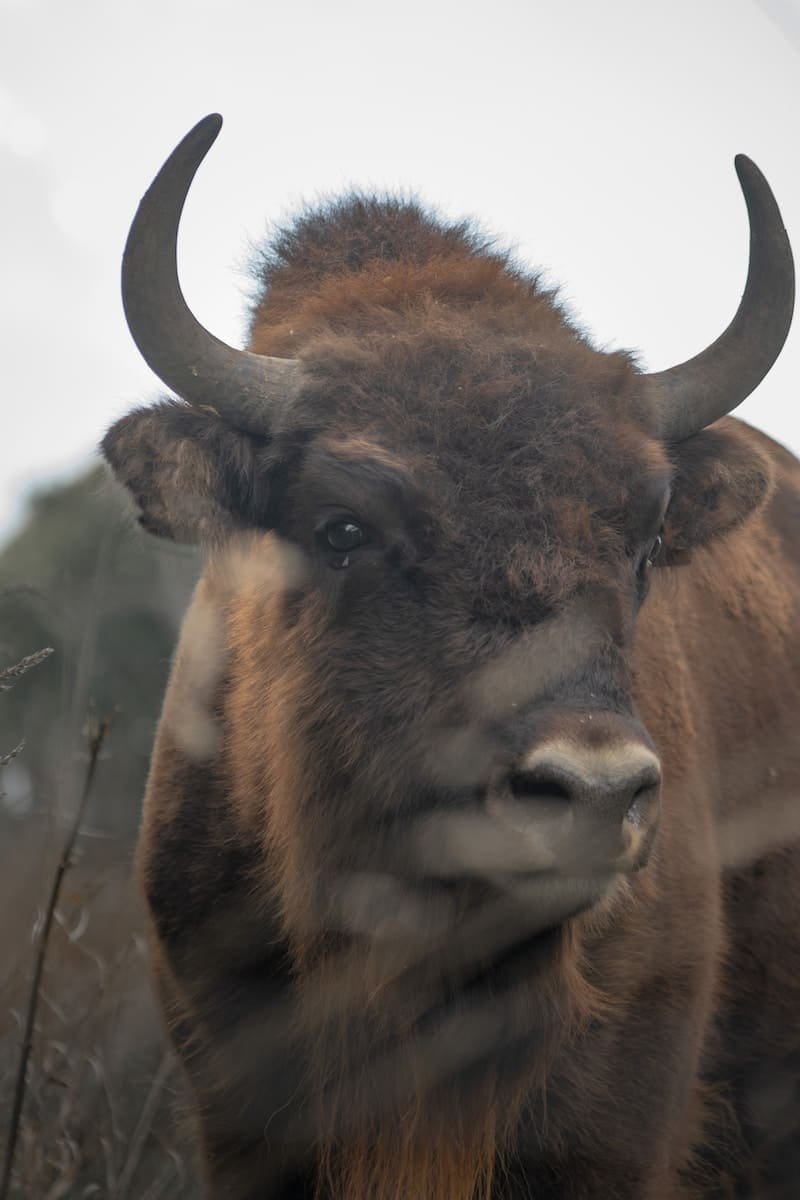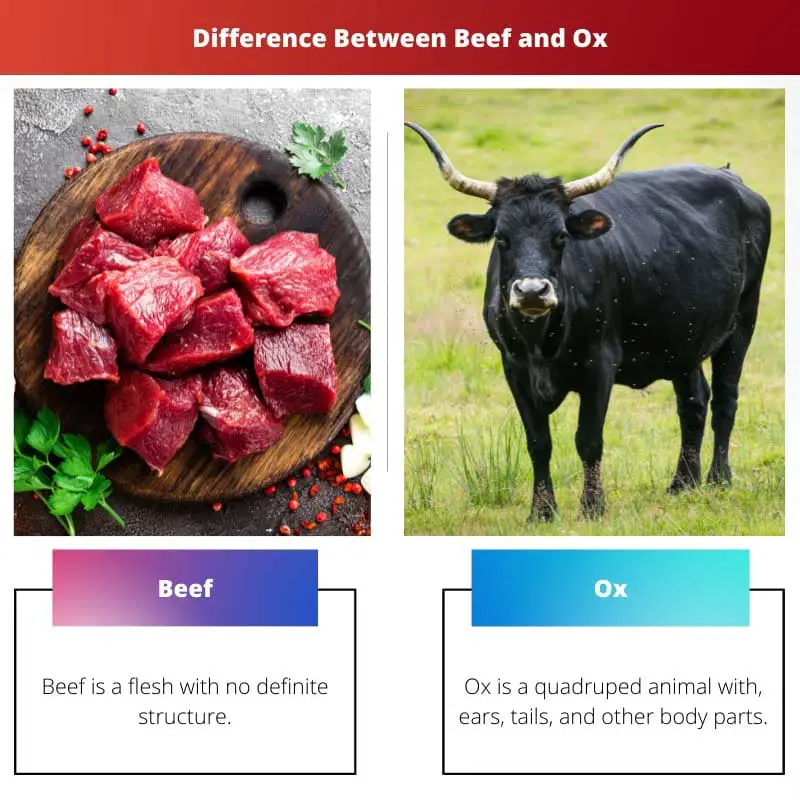Animals played an important role in the progress of the human race since time immemorial. One animal that has not lost its value among humans is Ox, Oxen (plural).
In the early human age, people used to hunt these magnificent wild beasts for their meat, skin, and fur. Years have passed, but the importance of these animals remains the same.
Key Takeaways
- Beef is the meat from cattle, while ox specifically refers to the meat from a domesticated, adult male bovine used for work or draft purposes.
- Oxen are larger and stronger than cattle bred for beef production.
- Ox meat is leaner and less tender than beef due to the increased muscle usage in working animals.
Beef vs Ox
The difference between Beef and Ox is that Beef is the meat or flesh of an adult bovine (which is grouped as cattle) consumed by humans as the main food source. Whereas Ox is a castrated bull used as a draught animal, it is trained for ploughing the fields, pulling carts, dragging wagons, etc.

Beef is a comestible name for the meat of a bull or cow, humans have hunted these animals since ancient times for their meat, fur, and skin.
After pork and chicken, Beef is the most consumed meat in the world. China, the USA, and Brazil are the largest producers of Beef. Alambre, Bakso, Balbacua, and Beef balls are some dishes made from Beef.
Instead of being slaughtered, Ox is retained for performing tasks. It is a castrated male bull, domesticated and trained for ploughing fields, threshing grains, pulling carts, etc.
The yoke (wooden crosspiece) helps the oxen pull heavier loads for longer periods; hence they are mainly used for farming purposes: breaking the sod, ploughing the field, and making the soil ready for growing crops.
Comparison Table
| Parameters of Comparison | Beef | Ox |
|---|---|---|
| Physical Structure | Ox is a quadruped animal with ears, tails, and other body parts. | It is used for agricultural purposes |
| Uses | It is used for consumption | It is used for agriculture purposes |
| Cost | Affordable | Costly |
| Harmful for environment | Harmful | Harmful |
| Living/Non-Living | Non-Living | Living |
What is Beef?
The flesh of an adult bovine (cow, steer, bull) is called Beef. It is considered one of the important food items in Western countries.
Beef is consumed mainly by Christians and Muslims people. Most Hindu people refrain from eating Beef as they consider it a sacred animal. Also, a cow is the national animal of Nepal; hence it is prohibited to consume Beef in Nepal as well.
Beef is rich in protein, iron, and B12. Consumption of beef in the right amount helps people suffering from a deficiency of these vitamins and minerals.
However, consuming beef in huge amounts can lead to several diseases, such as colorectal cancer, blood pressure, and coronary heart disease, especially if we take processed Beef.
It is the third-largest consumed meat all over the world. Therefore, we should monitor the intake of beef. As we know, the demand for Beef is increasing over time, and to satisfy the demand, people are engaged in animal husbandry.
Among all the animal products produced, Beef production requires a significant amount of land and water that, adds to the production of Green House Gas and deforestation, ultimately leading to Environmental threats.

What is Ox?
In ancient times the early humans hunted the aurochs (extinct cattle species); for meat and fur and later domesticated them for different farming purposes. From this, we came to know that cattle have had a vital role in the life of human beings since the time beginning.
One of the cattle species considered to be most helpful in farming is the Ox. These animals are being domesticated for various farming purposes such as; ploughing fields, drawing carts, riding, etc.
Ox is trained to serve different purposes on the farm. As they have huge body structures, sometimes it becomes difficult for farmers to control them, so they are castrated.
By inhibiting testosterone and aggression, castration makes the males tame and safer to work with.
Every year a pair of ox of about three years is bought and trained with the mature animals. They serve their purpose for seven years. At the age of seven, they are sold off to build up for Beef.
A vast forest area is being cleared for cattle rearing, leading to deforestation and increased environmental pollution.
Due to its significant role in deforestation and habitat destruction, animal husbandry causes biodiversity loss; species-rich habitats are destroyed.

Main Differences Between Beef and Ox
1. Beef is the flesh or meat of cattle. Whereas Ox is a bovine male.
2. Beef is used as a food item and consumed by many people worldwide. However, Ox
is an animal that is used for farming purposes.
3. Beef is affordable, but Ox, a living animal, is very costly.
4. Beef is a non-living food item. On the other hand, Ox is a living creature.
5. Beef does not have any fixed shape or structure. Whereas Ox has a definite body structure and size.

- https://www.cabdirect.org/cabdirect/abstract/20113161498
- https://rupress.org/jgp/article/45/6/1031/26736

The article provides an insightful comparison between ox and beef. The detailed history about the use of animals in farming and their importance in human life is very intriguing.
Yes, indeed. The article brings historical insight and educates about how animals have an important role from ancient times in human lives.
This is a very informative article about the importance of oxen in farming. The environmental impact of beef production mentioned here is a major concern for our planet.
It’s essential to bring awareness about the environmental threats associated with beef production. This article provides an in-depth analysis of the adverse impacts.
The mention of deforestation and habitat destruction due to animal husbandry reveals important environmental implications. We should consider its impact on the planet.
The historical context of cattle species’ importance in human life and the focus on environmental impacts of beef production make this article very compelling.
The comprehensive insights shared in this article deliver a compelling argument for a balanced perspective on beef consumption and its ecological implications.
The historical and environmental aspects discussed in this article are thought-provoking and provide a strong basis for understanding the broader impact of beef production.
The article provides a comprehensive understanding of the differences between beef and ox, especially emphasizing the environmental repercussions of beef production.
The detailed depiction of the environmental concerns associated with beef production presents a crucial argument for reconsidering our dietary choices.
The article offers a diverse perspective on the historical significance of cattle and the environmental impact of beef production, presenting a compelling case for consideration.
It’s compelling to view the historical and environmental aspects together in this article, emphasizing the importance of balanced understanding and awareness about beef consumption.
The comparison between beef and ox detailed in the article is truly fascinating. The explanations of their different uses and their environmental effects are well articulated.
I agree, the detailed comparison and the focus on environmental impact are thought-provoking. It raises awareness about sustainable practices and concerns.